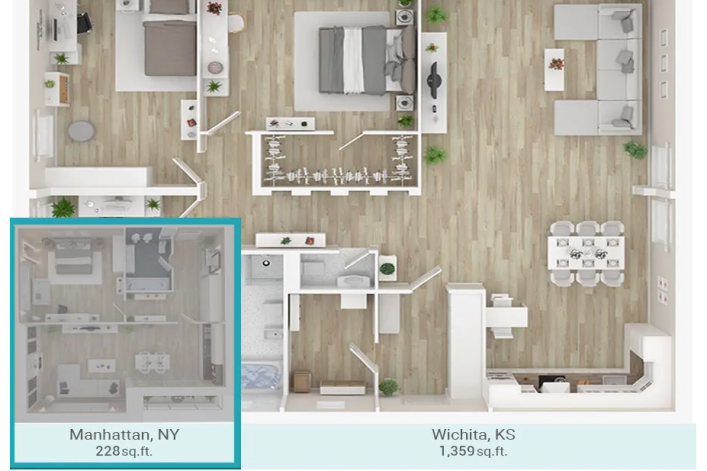How big an apartment can you get for $1,500 a month?
- It's a decent budget for many other U.S. cities but in NYC there are only 10 listings
- $1,500 would net Manhattanites a 228-square-foot fraction as per RentCafé's ranking

RentCafé analyzed what $1,500 gets you in major rental markets around the U.S. For that amount, Manhattanites could afford a fraction of a spread in Wichita, Kansas, ranked as the best deal on the list.
RentCafé analysis of Yardi Matrix data
Let’s say you had a budget of $1,500 to rent an apartment in New York City. What kind of place could you get?
If you were dead set on living on your own, with that budget your options would be limited to studios or very small one-bedroom apartments, and you wouldn’t have a big selection: There are currently a grand total of 10 rental apartments in NYC for $1,500 or less on StreetEasy. (A year ago, there were 20 units available.)
You won’t get much space for that rent either—and you have to head to the fringes of the outer boroughs. There’s a studio on Staten Island for $1,499 a month, and another one in Whitestone for $1,375. This Gravesend studio for $1,400 has central air and modern appliances. It’s not clear what you what this Highbridge unit looks like—the images for a $1,495 studio are of another unit.
You’ll have far more options if you take that budget and use it to share an apartment. For example, there are over 860 two bedrooms for under $3,000 and just over 1,000 three-bedroom apartments for $4,500 or less. Of course, living with roommates requires lots of compromises—and doesn’t necessarily mean you’ll get that much space to yourself. (Take Brick's advice and create a roommate agreement to keep the peace.)
[Editor's note: A previous version of the article ran in May 2023. We are presenting it again with updated information for July 2024.]
What you get across the U.S.
In most cities across the U.S., $1,500 a month would be a decent budget for a rental apartment. On the national level, a monthly rent of $1,500 will get you an average of 729 square feet of apartment, according to RentCafé's annual survey of apartment sizes that you can get for that amount in 200 large U.S. cities, which used Yardi Matrix data. More than 62 percent of the 200 largest cities offer more square feet than the national average.
The best deal is in Wichita, Kansas, by the way, where $1,500 will stretch to as much as 1,359 square feet for a rental.
In second place is Toldeo, Ohio, where you could rent 1,345 square feet of living space for $1,500, enough for a three or four bedroom. Following in third place is Oklahoma City, you can get 1,302 square feet for that rent, which is likely a three bedroom.
What makes NYC so maddeningly unique
But NYC is nothing like other cities, particularly when it comes to the rental market. RentCafé found $1,500 only gets Manhattanites 228 square feet. (Yardi Matrix data only covers Manhattan, Brooklyn, and Queens.)
To be clear, you’re not likely to find an apartment of that size in Manhattan.
“We know that in Manhattan you can’t really get a 200-something-square-foot apartment, besides maybe a micro unit. But that would be the area you get for this value,” a RentCafé spokesperson told Brick.
The area you can get in NYC has been shrinking: A year ago $1,500 brought you the equivalent of 243 square feet, and prior to that you could get 262 square feet. In 2017, that amount would have netted you 277 square feet.
Think of it like fractions—this is the average square feet that a $1,500 budget gets you in Manhattan these days. You’ll have to spend a lot more to get an actual apartment. Manhattan median rent in June was $4,300, according to the Elliman Report, which found that New Yorkers signed leases for smaller apartments.
Similarly in Brooklyn, a $1,500 budget will get renters 300 square feet and in Queens, you get 370 square feet.
Across the Hudson in Jersey City, another competitive rental market, you get the equivalent of 340 square feet for $1,500.
Is there such a thing as an apartment that is too small?
Turns out there’s no city-wide size requirement for NYC apartments, said Andrew Rudansky, press secretary for the Department of Buildings.
There is nothing in the building code or zoning rules that points to a definitive minimum size for apartments that is uniform across the city, he said. But there are minimum apartment sizes you could calculate based on code requirements for minimum room size, zoning, and whether they are in the Quality Housing Program. For example, a 2016 micro-unit apartment complex has apartments measuring 260 square feet, he adds.
“There are pre-existing single-room occupancy units that are smaller than that, which can be legally rented. You just can’t build new SROs in the city,” Rudansky said.
If you are considering a rental that is listed as an SRO, he recommended confirming that it is legal and meets safety requirements by checking city records, like Certificates of Occupancy, which are publicly available on DOB’s Buildings Information System website.
It's important to point out that while apartments may not have minimum sizes, bedrooms do have size requirements.
To be considered legal, bedrooms have to be at 80 least square feet, among other safety considerations—an important consideration if you are dividing up an apartment to share with roommates.
You Might Also Like































